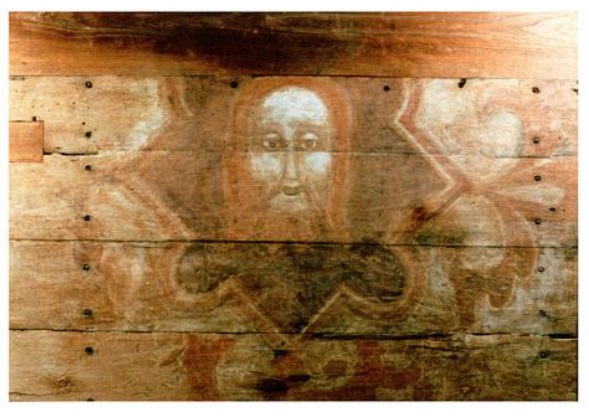The panel measures 145x85x5 cm, the thickness being greater than original as a supporting panel has been attached to the back. The uppermost plank is not original either and the pattern on that part is missing. Judging from the nail pattern the panel may originally have extended more to the left. Comparison of the painting with similar items suggests that the panel may well have been the lid of a (knight's) travel chest or a relic box.
Carbon dating was carried out by the University of Oxford laboratory. The resulting age was between 1280 and 1440, with >95% reliability. During the first decades of this time range there was a Templar preceptory nearby, between the donation of the mansion to the Templars in 1185 and its transfer to the Knights Hospitaller in November 1313. The result of the dating does not entirely exclude that the panel dates back to the Templar era, but makes it more likely that it is of a later time. So the panel can be more easily attributed to the time when the Hospitallers were in Templecombe rather than the Templars.
Many theories exist on what person is depicted, without conclusive evidence for any. Theories range from Jesus Christ to John the Baptist or even the Green Man, a mythical pagan figure. Similarities have been noted with the figure on the Turin Shroud, although the Templecombe Head has its mouth open, unlike the image on the Turin Shroud. It is also possible that this is a copy of the face depicted on the Mandylion or the Sudarium. Both the eastern mandile and the western Veronica depicted a face viewed from the front and with open eyes.
The Mandylion, also called the Image of Edessa, is a holy relic consisting of a piece of cloth upon which an image of the face of Jesus Christ had been miraculously imprinted without human intervention. The Sudarium or Veil of Veronica, also known as the Vernicle and often called simply the Veronica, has a similar miraculous origin.
Copies and depictions of boths cloths were common. In practice the Veronica was the western version of the mandylion. Around the fourteenth century the mandyle model was already widespread in Eastern churches from the Balkans to Russia to Turkey. In the West the Veronica model was spreading.
Is there any way to distinguish an eastern mandile from a western Veronica? The oriental copies were obviously made in a Byzantine style, which has remained fairly fixed over the centuries. In the West, depictions followed the development of pictorial styles. The appearance of Veronica's face also had an evolution. At first it was a clean face, bloodless and without a crown of thorns. Then there were also examples with the crown of thorns, following an evolution of the legend. The face could then also be streaked with blood. Much later, from about 1600, depictions of Veronica with closed eyes also appeared, perhaps influenced by the knowledge of the Shroud of Turin.
Around the fourteenth century a Mandylion and a Veronica could be quite similar, both with open eyes, without a crown of thorns and without blood. But there was one feature that could allow us to distinguish. The Mandylion always had a halo or nimbus, that is, a circle all around the face. Copies of the Veronica, on the other hand, could often be without a halo. Perhaps Western painters thought that if the image must have been produced as an imprint by contact with the face of Jesus, there was no reason that a halo was also imprinted.
Templecombe's head is devoid of a halo, so it undoubtedly conforms to the Western model of Veronica. Even the pictorial style, although hardly characterizable, is not that typical of a Byzantine icon. It can be added that the painted frame in the shape of a lobed lozenge was widespread in the West. Then there is a floral decoration, on the outside of the frame, which recalls typical motifs widespread in the West (think of the fleur de lis of the French or the coat of arms of Florence). In conclusion, the face of Templecombe does not have a halo and this distinguishes it from the oriental Mandylion model. As the style is not clearly definable but does not have a Byzantine aspect, the Templecombe head can be assumed to be a Western product.
To conclude, the Templecombe Head may be of Templar origin, although a later time of origin is more probable. The construction resembles some sort of chest lid, but the painting thereon resembles a religious Veronica portrait of Western origin. Therefore the lid may have covered a relic box.
This blog quotes edited sections from sindone.weebly.com, an 2015 blog by Ed Oldfield and several Wikipedia pages; illustration showing the Templecombe Head at St. Mary’s Church, Templecombe, Somerset, UK, The Bridgeman Art Library Nationality / copyright status: English / out of copyright, from this source

No comments:
Post a Comment